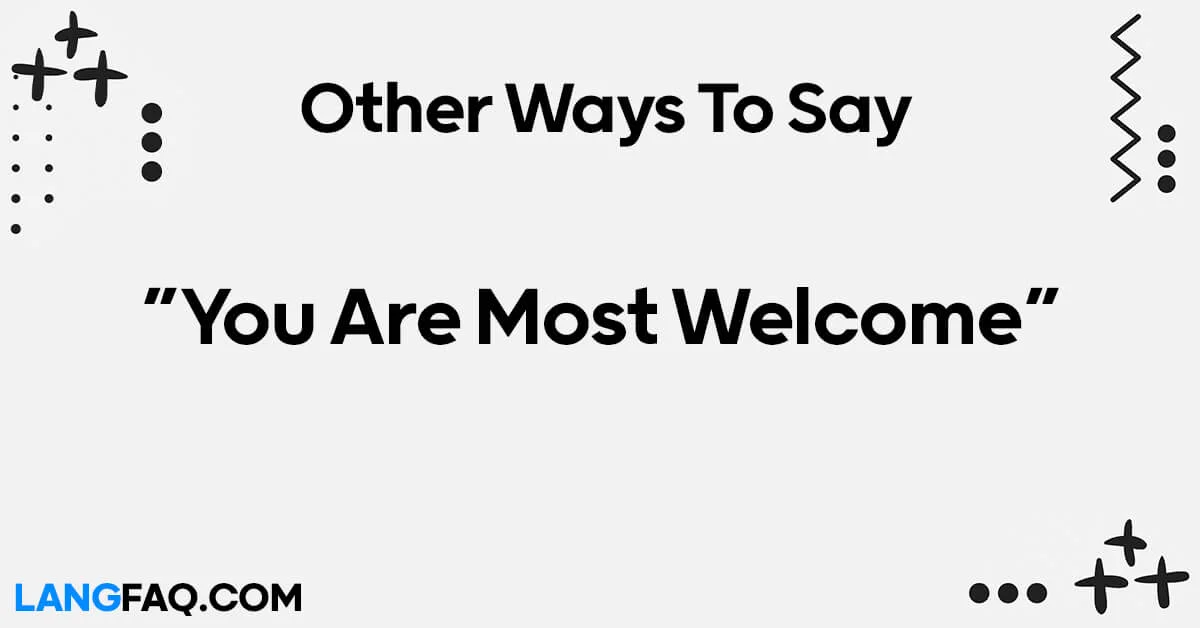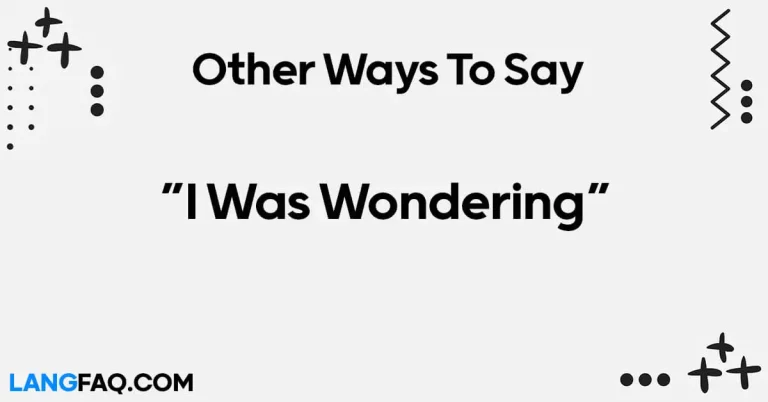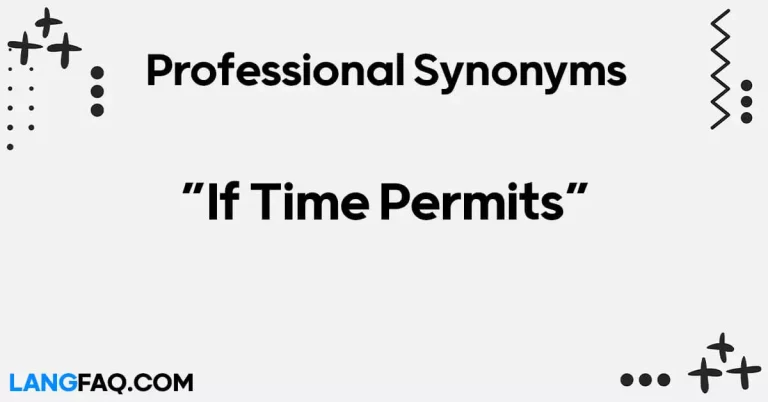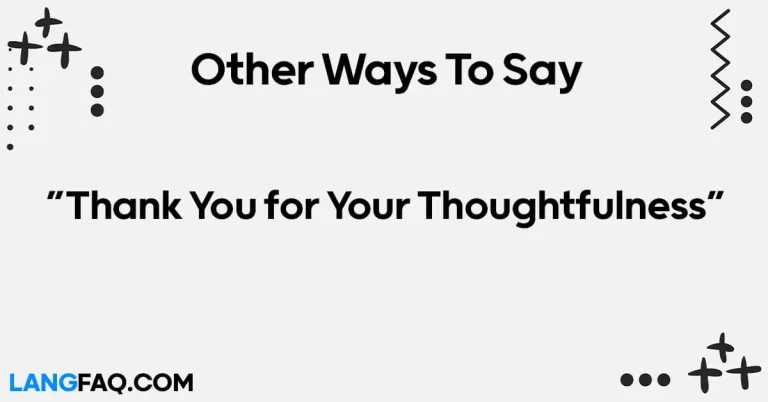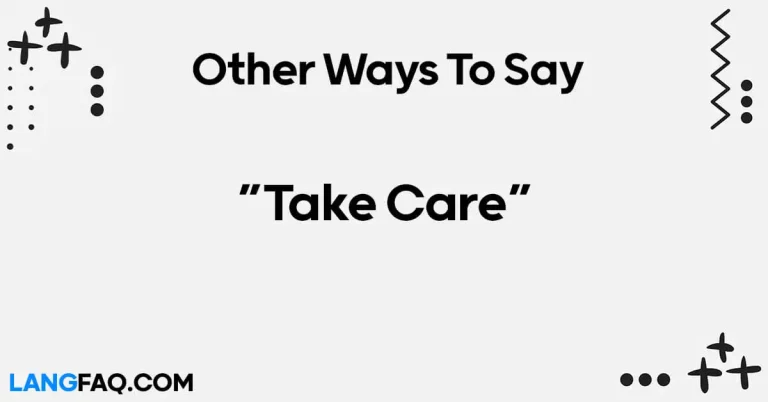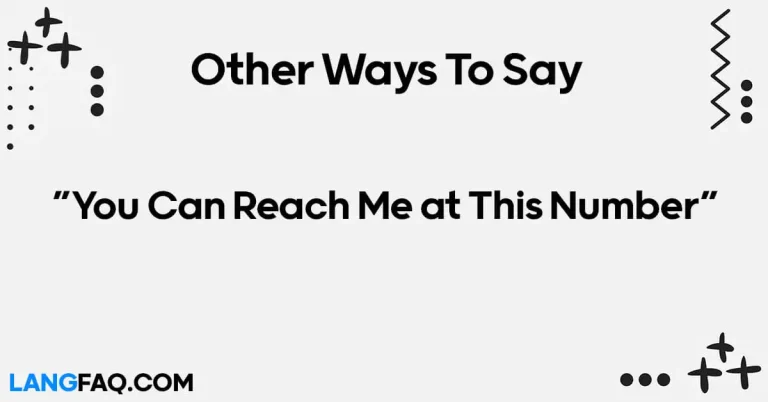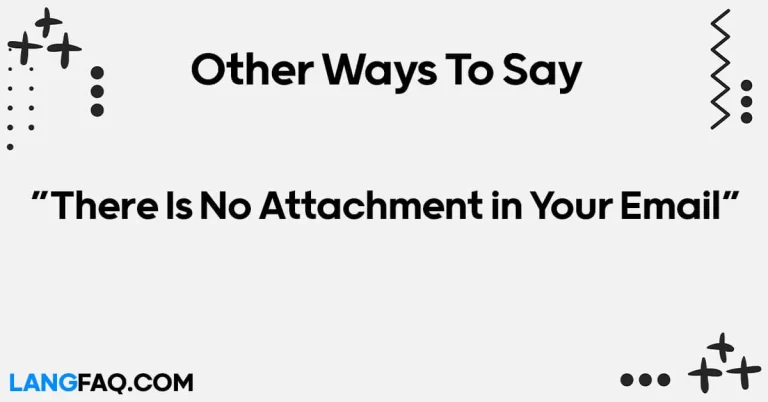Welcome to a linguistic journey where we explore delightful alternatives to the commonly used phrase “You Are Most Welcome.” Elevating your language proficiency and enriching your expressions can significantly enhance your communication skills. In this comprehensive guide, we’ll delve into 12 captivating ways to convey gratitude and welcome in various contexts. Let’s embark on this enlightening adventure together!
12 Other Ways to Say “You Are Most Welcome”
Here are 12 other ways to say “You Are Most Welcome”:
- You’re welcome
- It was my pleasure
- Think nothing of it
- Glad to help
- Not a problem
- Anytime
- Don’t mention it
- It’s nothing
- You bet
- No worries
- Happy to assist
- My pleasure
Here’s the table with meanings and examples for the 12 other ways to say “You Are Most Welcome”:
| Phrase | Meaning | Example |
|---|---|---|
| You’re welcome | A polite response to thanks | “Thank you for your help.” “You’re welcome!” |
| It was my pleasure | Indicates that helping was enjoyable | “Thanks for the assistance.” “It was my pleasure.” |
| Think nothing of it | Suggests that the favor was minor and not a burden | “I appreciate your help.” “Think nothing of it.” |
| Glad to help | Expresses willingness to assist | “Can you lend a hand?” “Glad to help.” |
| Not a problem | Indicates that helping was easy | “Thanks for the support.” “Not a problem.” |
| Anytime | Implies readiness to help at any time | “I owe you one.” “Anytime.” |
| Don’t mention it | Humble response to gratitude | “I’m grateful for your help.” “Don’t mention it.” |
| It’s nothing | Suggests that the favor was insignificant | “Thanks a lot.” “It’s nothing.” |
| You bet | Indicates assurance or agreement | “I really appreciate it.” “You bet.” |
| No worries | Assures that there’s no need for concern | “Sorry for the trouble.” “No worries.” |
| Happy to assist | Conveys willingness to help happily | “Thanks for your support.” “Happy to assist.” |
| My pleasure | Indicates that helping was enjoyable | “Thank you for your kindness.” “My pleasure.” |
These diverse expressions not only convey gratitude but also enrich our interactions with warmth and sincerity. Whether acknowledging a favor or extending courtesies, incorporating these phrases into our communication fosters positive connections and enhances the overall experience of expressing gratitude and welcome.
Is It Correct to Say “You Are Most Welcome”?
Yes, “You are most welcome” is a correct and polite way to respond to someone’s thanks or gratitude. It is a formal and gracious expression used to acknowledge appreciation and to convey that the person is genuinely welcome to whatever assistance or gesture was offered.
The phrase “You are most welcome” can be used in a variety of contexts, from professional settings to personal interactions. It is commonly used in response to expressions of gratitude, such as “Thank you” or “Thanks,” and it signifies that the speaker is pleased to have been of help or service.
In addition to being grammatically correct, “You are most welcome” is considered courteous and respectful. It acknowledges the gratitude of the person thanking you while also reaffirming your willingness to assist them in the future.
Overall, “You are most welcome” is a polite and appropriate response in situations where you want to express hospitality, kindness, and appreciation for the gratitude expressed towards you.
Professional Mail Example With “You Are Most Welcome”
Subject: Re: Project Assistance
Dear [Colleague’s Name],
I hope this email finds you well. Thank you for reaching out regarding the assistance with the project. I’m glad I could be of help.
You are most welcome! It was my pleasure to lend a hand and contribute to the success of the project. I appreciate the opportunity to collaborate with you and the team.
Please don’t hesitate to let me know if there’s anything else I can assist you with. I’m here to support and contribute in any way I can.
Looking forward to our continued collaboration.
Best regards, [Your Name]
You’re Welcome:
When someone expresses gratitude, responding with “You’re welcome” is a classic way to acknowledge their thanks. It’s a polite and versatile phrase suitable for both formal and informal contexts.
Scenario: Imagine a colleague thanking you for helping them with a project. You can respond with “You’re welcome” to graciously accept their gratitude.
Example Sentence: Colleague: “Thanks for assisting me with the presentation.” You: “You’re welcome. Glad I could help.”
Variations:
- Formal Variation: “You’re most welcome”
- Informal Variation: “No problem at all”
- Colloquial Variation: “Don’t mention it”
Email Sample:
Subject: Re: Assistance with Presentation
Dear [Colleague’s Name],
You’re welcome! I’m glad I could be of help. Let me know if there’s anything else I can assist you with in the future.
Best regards, [Your Name]
Explanation: “You’re welcome” is a straightforward and polite response to expressions of gratitude. It acknowledges the thanks given and reinforces a positive interaction. In formal contexts, adding “most” before “welcome” enhances the formality of the response. In informal settings, phrases like “no problem at all” or “don’t mention it” convey a relaxed and friendly tone.
Pros:
- Universally understood and accepted
- Polite and courteous
- Suitable for various situations and relationships
Cons:
- Can sometimes feel overused or insincere if not accompanied by genuine gratitude
Related Insights: According to the Cambridge Dictionary, “You’re welcome” is defined as “a polite way of replying to someone who has thanked you.” It’s a common phrase used in everyday communication to acknowledge gratitude.
Grammar/Usage Rules:
- Always use “you’re” (contraction of “you are”) instead of “your” (possessive form) in this phrase.
Tips:
- Accompany “You’re welcome” with a genuine smile or nod for added sincerity.
- Use variations like “You’re most welcome” in formal correspondence to elevate the level of politeness.
Incorporating “You’re welcome” into your communication repertoire enhances your ability to respond graciously to expressions of gratitude, fostering positive relationships and interactions.
It Was My Pleasure:
When you want to convey that assisting someone was enjoyable and fulfilling, saying “It was my pleasure” adds a personal touch to your response.
Scenario: After helping a friend move into their new apartment, they express their gratitude. Responding with “It was my pleasure” conveys that you found joy in assisting them.
Example Sentence: Friend: “Thanks for helping me move. I really appreciate it.” You: “It was my pleasure. I’m glad I could be there for you.”
Variations:
- Formal Variation: “It was indeed my pleasure”
- Informal Variation: “I enjoyed it”
- Colloquial Variation: “Happy to help”
Email Sample:
Subject: Re: Moving Assistance
Hi [Friend’s Name],
It was truly my pleasure to help you with the move. Let me know if there’s anything else you need assistance with in the future.
Warm regards, [Your Name]
Explanation: “It was my pleasure” goes beyond a simple acknowledgment of thanks; it expresses genuine joy and satisfaction in being able to assist someone. This phrase adds a personal touch to your response, showing that you found fulfillment in helping.
Pros:
- Conveys sincerity and genuine pleasure in assisting
- Adds a personal touch to your response
- Suitable for both formal and informal contexts
Cons:
- May sound overly formal in some casual situations
Related Insights: The phrase “It was my pleasure” is idiomatic and implies that the speaker found joy or satisfaction in the action they took. It’s often used to respond to expressions of gratitude in customer service interactions and personal relationships.
Grammar/Usage Rules:
- Ensure the subject and verb agreement (e.g., “It was my pleasure” for singular subjects, “They were my pleasure” for plural subjects).
Tips:
- Use “It was my pleasure” sparingly to maintain its sincerity and impact.
- Pair this phrase with a smile or positive body language to enhance its effect.
By incorporating “It was my pleasure” into your responses to gratitude, you can convey genuine joy and satisfaction in assisting others, fostering deeper connections and mutual appreciation.
Think Nothing of It:
When you want to downplay the favor you’ve done for someone and reassure them that it was no trouble at all, “Think nothing of it” is a perfect phrase to use. It conveys humility and reassurance, showing that you’re happy to help without expecting anything in return.
Scenario: Imagine a friend thanking you for picking them up from the airport. You can respond with “Think nothing of it” to assure them that it was no inconvenience on your part.
Example Sentence: Friend: “Thanks for picking me up. It must have been a hassle.” You: “Think nothing of it! I’m always happy to help out a friend.”
Variations:
- Formal Variation: “Please, think nothing of it”
- Informal Variation: “No biggie”
- Colloquial Variation: “Don’t sweat it”
Email Sample:
Subject: Re: Airport Pickup
Hey [Friend’s Name],
Think nothing of it! I was happy to pick you up. Let me know if you need anything else.
Take care, [Your Name]
Explanation: “Think nothing of it” reassures the recipient that the favor was no inconvenience or burden to you. It’s a humble way of downplaying the act of kindness while still expressing willingness to help.
Pros:
- Humble and modest response
- Reassures the recipient that the favor was no trouble
- Suitable for casual and formal contexts
Cons:
- May come across as overly casual in very formal situations
Related Insights: According to Merriam-Webster, “Think nothing of it” is an idiomatic expression used to minimize the significance of something. It’s often used in response to expressions of thanks or appreciation.
Grammar/Usage Rules:
- Ensure the subject-verb agreement (e.g., “Think nothing of it” for singular subjects, “Think nothing of them” for plural subjects).
Tips:
- Use “Think nothing of it” with a warm tone and sincere smile to convey genuine reassurance.
- Avoid using this phrase in situations where a more formal response is required.
By incorporating “Think nothing of it” into your responses, you can reassure others that their requests or favors are no trouble at all, fostering a sense of comfort and appreciation in your interactions.
Glad to Help:
Expressing that you’re glad to assist someone not only acknowledges their gratitude but also conveys your willingness to lend a hand whenever needed. “Glad to help” is a friendly and sincere way to respond to expressions of thanks.
Scenario: A colleague thanks you for covering their shift at work. Responding with “Glad to help” shows that you were happy to assist and reinforces your reliability as a team member.
Example Sentence: Colleague: “Thanks for covering my shift. I owe you one.” You: “Glad to help! We’re a team, after all.”
Variations:
- Formal Variation: “I’m pleased to have been of assistance”
- Informal Variation: “Happy to pitch in”
- Colloquial Variation: “No problem, anytime”
Email Sample:
Subject: Re: Shift Coverage
Hi [Colleague’s Name],
Glad to help out! Don’t hesitate to ask if you need backup in the future.
Best, [Your Name]
Explanation: “Glad to help” expresses genuine pleasure in assisting someone. It communicates your willingness to lend a hand and reinforces positive teamwork and cooperation.
Pros:
- Conveys sincerity and willingness to assist
- Reinforces positive relationships and teamwork
- Suitable for both formal and informal contexts
Cons:
- May sound overly casual in very formal situations
Related Insights: According to the Oxford Learner’s Dictionary, “glad” is an adjective meaning pleased and happy about something. In the phrase “Glad to help,” “glad” emphasizes your positive feelings about assisting.
Grammar/Usage Rules:
- Use “Glad to help” as a complete sentence to respond to expressions of thanks or gratitude.
Tips:
- Use “Glad to help” with a warm tone and genuine smile to convey sincerity.
- Pair this phrase with specific details about the assistance provided to personalize your response.
By incorporating “Glad to help” into your responses, you can express genuine pleasure in assisting others and reinforce positive relationships and teamwork in various contexts.
Not a Problem:
When someone expresses gratitude for something you’ve done, responding with “Not a problem” reassures them that their request or favor was no inconvenience to you. It conveys a relaxed and casual attitude, indicating that you were happy to help without any hassle.
Scenario: A friend thanks you for lending them your notes for an exam. Responding with “Not a problem” shows that you were happy to assist and that it was no trouble at all.
Example Sentence: Friend: “Thanks for letting me borrow your notes. I appreciate it.” You: “Not a problem! Happy to help you out.”
Variations:
- Formal Variation: “It was no trouble at all”
- Informal Variation: “No biggie”
- Colloquial Variation: “No sweat”
Email Sample:
Subject: Re: Note Borrowing
Hey [Friend’s Name],
Not a problem at all! Let me know if you need anything else.
Best, [Your Name]
Explanation: “Not a problem” reassures the recipient that their request or favor was no inconvenience to you. It’s a casual and relaxed way to respond to expressions of thanks, conveying a positive and helpful attitude.
Pros:
- Casual and friendly response
- Reassures the recipient that the favor was no trouble
- Suitable for informal contexts and conversations
Cons:
- May sound overly informal in very formal situations
Related Insights: According to Collins Dictionary, “Not a problem” is an idiomatic expression used to assure someone that what they have said or asked is not causing trouble or inconvenience.
Grammar/Usage Rules:
- Ensure subject-verb agreement (e.g., “Not a problem” for singular subjects, “Not problems” for plural subjects).
Tips:
- Use “Not a problem” with a friendly tone and relaxed demeanor to convey sincerity.
- Avoid using this phrase in very formal or professional contexts where a more formal response is required.
By incorporating “Not a problem” into your responses, you can reassure others that their requests or favors were no trouble at all, fostering positive interactions and relationships.
Anytime:
When you want to convey that you’re always available to help someone, responding with “Anytime” expresses your willingness to assist at any time without hesitation. It’s a friendly and reassuring phrase that emphasizes your availability and supportiveness.
Scenario: A neighbor thanks you for helping them with yard work. Responding with “Anytime” shows that you’re always willing to lend a hand whenever they need it.
Example Sentence: Neighbor: “Thanks for helping me with the yard work. I owe you one.” You: “Anytime! Don’t hesitate to ask if you need help in the future.”
Variations:
- Formal Variation: “You can count on me anytime”
- Informal Variation: “Whenever you need me”
- Colloquial Variation: “I’m here for you”
Email Sample:
Subject: Re: Yard Work Assistance
Hi [Neighbor’s Name],
Anytime! I’m always happy to help out. Let me know if there’s anything else you need assistance with.
Take care, [Your Name]
Explanation: “Anytime” communicates your availability and willingness to assist at any time without hesitation. It’s a friendly and reassuring response that emphasizes your supportiveness and reliability.
Pros:
- Emphasizes availability and supportiveness
- Reassures the recipient that you’re always willing to help
- Suitable for both formal and informal contexts
Cons:
- May sound overly casual in very formal situations
Related Insights: According to Macmillan Dictionary, “Anytime” is an adverb used to say that you can do something or see someone whenever they want.
Grammar/Usage Rules:
- “Anytime” is often used as a standalone response and doesn’t require additional context.
Tips:
- Use “Anytime” to express your availability and willingness to help in various situations.
- Pair this phrase with specific offers of assistance to personalize your response and reinforce your supportiveness.
By incorporating “Anytime” into your responses, you can convey your availability and supportiveness, fostering positive relationships and interactions with others.
Don’t Mention It:
When you want to downplay the favor you’ve done for someone and reassure them that it was no trouble at all, “Don’t mention it” is a perfect phrase to use. It conveys humility and reassurance, showing that you’re happy to help without expecting anything in return.
Scenario: Imagine a friend thanking you for helping them move furniture. You can respond with “Don’t mention it” to assure them that it was no inconvenience on your part.
Example Sentence: Friend: “Thanks for helping me move the furniture. I really appreciate it.” You: “Don’t mention it! I’m always here to lend a hand.”
Variations:
- Formal Variation: “It was my pleasure”
- Informal Variation: “No problem at all”
- Colloquial Variation: “It’s all good”
Email Sample:
Subject: Re: Furniture Moving Assistance
Hey [Friend’s Name],
Don’t mention it! I’m glad I could help out. Let me know if there’s anything else you need assistance with.
Best, [Your Name]
Explanation: “Don’t mention it” reassures the recipient that the favor was no inconvenience or burden to you. It’s a humble way of downplaying the act of kindness while still expressing willingness to help.
Pros:
- Humble and modest response
- Reassures the recipient that the favor was no trouble
- Suitable for both formal and informal contexts
Cons:
- May come across as overly casual in very formal situations
Related Insights: According to Merriam-Webster, “Don’t mention it” is an idiomatic expression used to minimize the significance of something. It’s often used in response to expressions of thanks or appreciation.
Grammar/Usage Rules:
- Ensure the subject-verb agreement (e.g., “Don’t mention it” for singular subjects, “Don’t mention them” for plural subjects).
Tips:
- Use “Don’t mention it” with a warm tone and sincere smile to convey genuine reassurance.
- Avoid using this phrase in situations where a more formal response is required.
By incorporating “Don’t mention it” into your responses, you can reassure others that their requests or favors are no trouble at all, fostering a sense of comfort and appreciation in your interactions.
It’s Nothing:
When someone expresses gratitude for something you’ve done, responding with “It’s nothing” reassures them that their request or favor was no inconvenience to you. It conveys humility and downplays the significance of the favor, showing that you’re happy to help without expecting anything in return.
Scenario: Imagine a colleague thanking you for staying late to help them with a project. You can respond with “It’s nothing” to reassure them that it was no trouble at all.
Example Sentence: Colleague: “Thanks for staying late to help me with the project. I really appreciate it.” You: “It’s nothing! I’m always here to support the team.”
Variations:
- Formal Variation: “It was my pleasure”
- Informal Variation: “No problem at all”
- Colloquial Variation: “It’s all good”
Email Sample:
Subject: Re: Project Assistance
Hi [Colleague’s Name],
It’s nothing! I’m glad I could assist you. Let me know if there’s anything else you need help with.
Best regards, [Your Name]
Explanation: “It’s nothing” reassures the recipient that the favor was no trouble or inconvenience to you. It’s a humble way of downplaying the significance of the act of kindness while still expressing willingness to help.
Pros:
- Humble and modest response
- Reassures the recipient that the favor was no trouble
- Suitable for both formal and informal contexts
Cons:
- May come across as overly casual in very formal situations
Related Insights: According to the Cambridge Dictionary, “It’s nothing” is an idiomatic expression used to reassure someone that something is not a problem or was not difficult or important.
Grammar/Usage Rules:
- Ensure subject-verb agreement (e.g., “It’s nothing” for singular subjects, “They’re nothing” for plural subjects).
Tips:
- Use “It’s nothing” with a warm tone and sincere demeanor to convey genuine reassurance.
- Avoid using this phrase in very formal or professional contexts where a more formal response is required.
By incorporating “It’s nothing” into your responses, you can reassure others that their requests or favors were no trouble at all, fostering positive interactions and relationships.
You Bet:
When you want to express assurance or agreement in response to someone’s gratitude, “You bet” is a casual and friendly phrase to use. It conveys confidence and enthusiasm, indicating that you’re happy to help and would do it again without hesitation.
Scenario: A friend thanks you for helping them move furniture. Responding with “You bet” shows that you’re confident in your ability to assist and would do it again if needed.
Example Sentence: Friend: “Thanks for helping me move the furniture. I really appreciate it.” You: “You bet! Anytime you need a hand, just let me know.”
Variations:
- Formal Variation: “Of course”
- Informal Variation: “Absolutely”
- Colloquial Variation: “You got it”
Email Sample:
Subject: Re: Furniture Moving Assistance
Hey [Friend’s Name],
You bet! I’m always here to help out. Don’t hesitate to ask if you need anything else.
Take care, [Your Name]
Explanation: “You bet” expresses confidence and enthusiasm in your ability to assist. It conveys assurance and willingness to help without hesitation, fostering positive interactions and relationships.
Pros:
- Casual and friendly response
- Conveys confidence and enthusiasm
- Suitable for informal contexts and conversations
Cons:
- May sound overly casual in very formal situations
Related Insights: According to Merriam-Webster, “You bet” is an idiomatic expression used to say that something is certain or to express agreement or understanding.
Grammar/Usage Rules:
- Ensure subject-verb agreement (e.g., “You bet” for singular subjects, “You all bet” for plural subjects).
Tips:
- Use “You bet” with a confident tone and friendly demeanor to convey genuine assurance.
- Pair this phrase with specific offers of assistance to personalize your response and reinforce your willingness to help.
By incorporating “You bet” into your responses, you can express confidence and enthusiasm in assisting others, fostering positive relationships and interactions.
No Worries:
When someone expresses gratitude for something you’ve done, responding with “No worries” reassures them that their request or favor was no trouble to you at all. It conveys a relaxed and easy-going attitude, indicating that you’re happy to help without any concerns or reservations.
Scenario: A colleague thanks you for covering their shift at work. Responding with “No worries” shows that you don’t mind helping out and that it was no trouble for you.
Example Sentence: Colleague: “Thanks for covering my shift. I owe you one.” You: “No worries! Happy to help out whenever you need.”
Variations:
- Formal Variation: “It’s no trouble at all”
- Informal Variation: “Don’t sweat it”
- Colloquial Variation: “It’s all good”
Email Sample:
Subject: Re: Shift Coverage
Hi [Colleague’s Name],
No worries at all! I’m always happy to lend a hand. Let me know if there’s anything else I can assist you with.
Best regards, [Your Name]
Explanation: “No worries” reassures the recipient that their request or favor was no trouble or inconvenience to you. It conveys a relaxed and easy-going attitude, fostering positive interactions and relationships.
Pros:
- Relaxed and easy-going response
- Reassures the recipient that the favor was no trouble
- Suitable for informal contexts and conversations
Cons:
- May sound overly casual in very formal situations
Related Insights: According to the Collins Dictionary, “No worries” is an idiomatic expression used to reassure someone that there is no problem or cause for concern.
Grammar/Usage Rules:
- Ensure subject-verb agreement (e.g., “No worries” for singular subjects, “No worri” for plural subjects).
Tips:
- Use “No worries” with a relaxed tone and friendly demeanor to convey genuine reassurance.
- Avoid using this phrase in very formal or professional contexts where a more formal response is required.
By incorporating “No worries” into your responses, you can reassure others that their requests or favors were no trouble at all, fostering positive interactions and relationships.
Happy to Assist:
Expressing that you’re happy to assist someone not only acknowledges their gratitude but also conveys your willingness to lend a hand with genuine joy. “Happy to assist” is a friendly and sincere way to respond to expressions of thanks, emphasizing your pleasure in being able to help.
Scenario: A friend thanks you for proofreading their essay. Responding with “Happy to assist” shows that you found joy in assisting them and reinforces your willingness to help in the future.
Example Sentence: Friend: “Thanks for proofreading my essay. I really appreciate it.” You: “Happy to assist! Let me know if you need help with anything else.”
Variations:
- Formal Variation: “I’m delighted to have been of service”
- Informal Variation: “I enjoyed it”
- Colloquial Variation: “Glad I could help”
Email Sample:
Subject: Re: Essay Proofreading
Hi [Friend’s Name],
Happy to assist with the proofreading! Don’t hesitate to reach out if you need further assistance.
Best regards, [Your Name]
Explanation: “Happy to assist” expresses genuine joy and satisfaction in being able to help someone. It conveys your willingness to lend a hand with enthusiasm and reinforces positive relationships and cooperation.
Pros:
- Conveys sincerity and genuine pleasure in assisting
- Adds a personal touch to your response
- Suitable for both formal and informal contexts
Cons:
- May sound overly formal in some casual situations
Related Insights: According to the Merriam-Webster Dictionary, “happy” is an adjective meaning pleased or glad. In the phrase “Happy to assist,” “happy” emphasizes your positive feelings about helping.
Grammar/Usage Rules:
- Ensure the subject-verb agreement (e.g., “Happy to assist” for singular subjects, “Happy to assist you” for plural subjects).
Tips:
- Use “Happy to assist” with a warm tone and sincere smile to convey genuine joy and willingness to help.
- Pair this phrase with specific offers of assistance to personalize your response and reinforce your supportiveness.
By incorporating “Happy to assist” into your responses, you can convey genuine joy and satisfaction in assisting others, fostering positive relationships and cooperation.
My Pleasure:
When you want to convey that assisting someone was truly enjoyable and fulfilling, saying “My pleasure” adds a personal touch to your response. It indicates that you found joy in being able to help and reinforces your willingness to assist in the future.
Scenario: A colleague thanks you for taking the time to mentor them. Responding with “My pleasure” shows that you found fulfillment in assisting them and that you’re always willing to offer guidance.
Example Sentence: Colleague: “Thanks for mentoring me through the project. I learned a lot.” You: “My pleasure! I’m always here to support your growth.”
Variations:
- Formal Variation: “It was indeed my pleasure”
- Informal Variation: “I enjoyed it”
- Colloquial Variation: “Happy to help”
Email Sample:
Subject: Re: Project Mentorship
Hi [Colleague’s Name],
My pleasure! I’m glad I could be of help. Let me know if you have any more questions or need further guidance.
Best regards, [Your Name]
Explanation: “My pleasure” goes beyond a simple acknowledgment of thanks; it expresses genuine joy and satisfaction in being able to assist someone. This phrase adds a personal touch to your response, showing that you found fulfillment in helping.
Pros:
- Conveys sincerity and genuine pleasure in assisting
- Adds a personal touch to your response
- Suitable for both formal and informal contexts
Cons:
- May sound overly formal in some casual situations
Related Insights: According to the Cambridge Dictionary, “pleasure” is a noun meaning enjoyment, satisfaction, or happiness. In the phrase “My pleasure,” “pleasure” emphasizes your positive feelings about assisting.
Grammar/Usage Rules:
- Ensure the subject-verb agreement (e.g., “My pleasure” for singular subjects, “Our pleasure” for plural subjects).
Tips:
- Use “My pleasure” with a warm tone and genuine smile to convey sincere joy and willingness to help.
- Pair this phrase with specific offers of assistance to personalize your response and reinforce your supportiveness.
By incorporating “My pleasure” into your responses, you can convey genuine joy and satisfaction in assisting others, fostering positive relationships and mutual appreciation.
Conclusion:
In conclusion, enriching your vocabulary with diverse expressions for “You Are Most Welcome” enhances your ability to communicate effectively and express gratitude sincerely. By incorporating these alternative phrases into your conversations, you can elevate your interactions and cultivate meaningful relationships built on mutual respect and appreciation. Embrace the beauty of language diversity and let your expressions resonate with warmth and authenticity.
FAQs
Q: How can I incorporate these alternative phrases into my daily conversations?
A: Integrating these alternative phrases into your daily interactions is simple. Practice using them in various contexts, such as when responding to gratitude, extending invitations, or acknowledging kindness. Over time, these phrases will become natural parts of your communication repertoire.
Q: Are there cultural considerations to keep in mind when using alternative expressions for “You Are Most Welcome”?
A: Absolutely. It’s essential to be mindful of cultural nuances and customs when using language. Some phrases may carry different connotations or meanings in different cultures. Consider the context and your audience to ensure your expressions are appropriate and well-received.
Q: Can I use these alternative phrases in written communication as well?
A: Yes, indeed! These alternative expressions can enhance written communication too. Whether in emails, letters, or social media messages, incorporating diverse language enriches your written interactions and adds a personal touch to your communication.
Q: Are there situations where certain alternative phrases are more suitable than others?
A: Certainly. The suitability of alternative phrases depends on the context and tone of the conversation. For instance, “You’re welcome” is versatile and can be used in various situations, while “My pleasure” or “Glad to help” may convey a more personalized response.
Q: How can I remember to use these alternative phrases effectively?
A: Practice is key. Start by consciously incorporating these phrases into your conversations until they become second nature. You can also create mental cues or reminders to prompt their usage in appropriate situations.
Q: What if I’m unsure which alternative phrase to use in a particular scenario?
A: Trust your instincts and opt for the phrase that feels most genuine and appropriate to the situation. Remember, sincerity and authenticity are paramount when expressing gratitude or extending courtesies.
Q: Can I modify these alternative phrases to suit specific contexts or relationships?
A: Absolutely. Feel free to personalize these phrases to better reflect your personality or the nature of your relationship with the individual. Adding a personal touch can make your expressions of gratitude or welcome even more meaningful.
Q: How can I encourage others to use alternative expressions for “You Are Most Welcome”?
A: Lead by example. Incorporate these alternative phrases into your own communication and share their effectiveness and versatility with others. Encourage open dialogue about language diversity and the impact of words on interpersonal connections.

